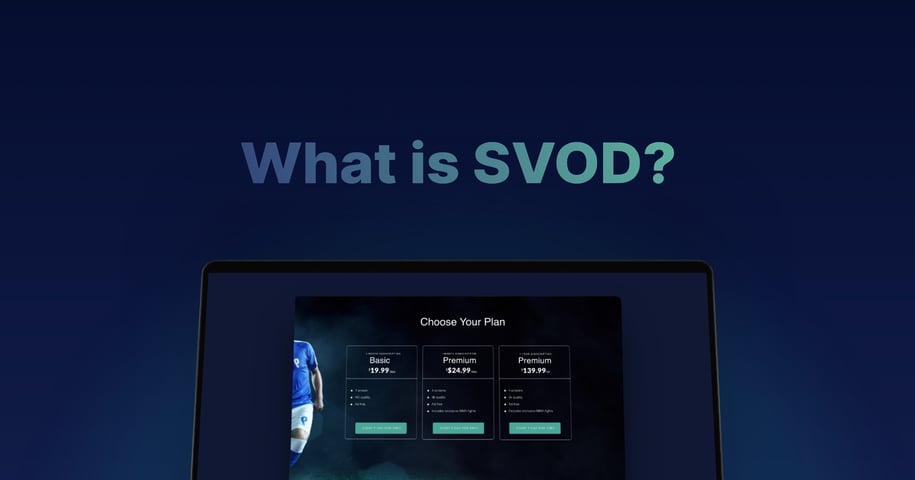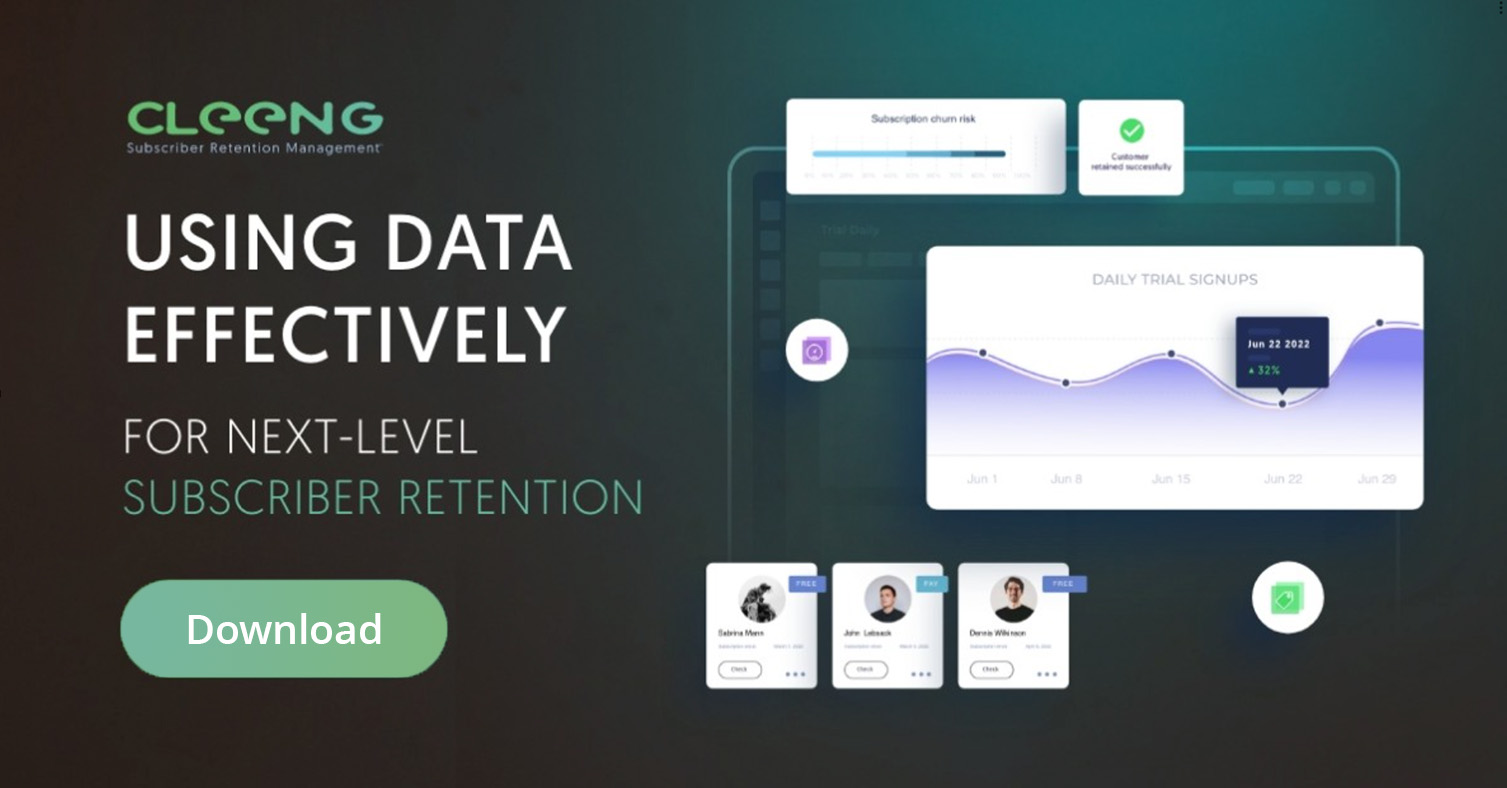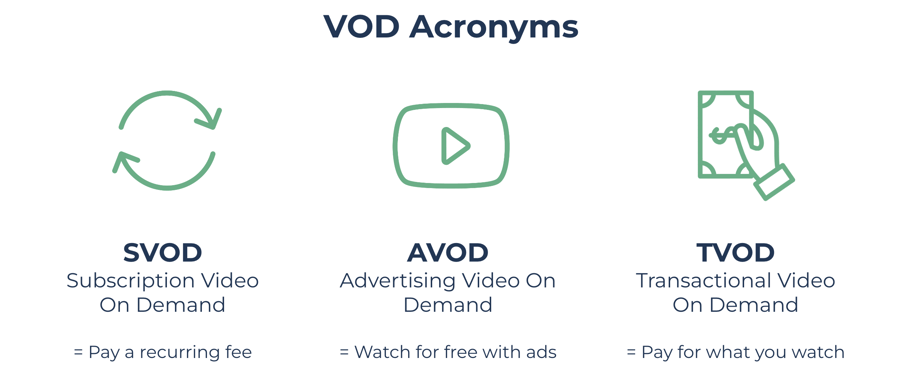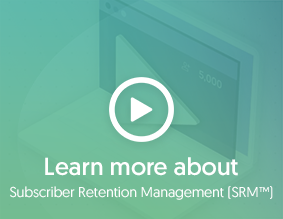
The entertainment industry has evolved to provide various choices at our fingertips. We can now stream over-the-top content on mobiles, tablets, and TVs, leading to an increase in demand for Video on Demand (VOD) services. Experts predict that the VoD market will reach up to $90 billion by 2024.
Broadcasters have three main options for monetizing their content:
- Subscription Video On Demand (SVOD)
- Advertising Video On Demand (AVOD)
- Transactional Video On Demand (TVOD)
To better understand these models, you can learn all about SVOD services in this guide. We’ll be covering the following topics:
- What is SVOD?
- Examples of SVOD services
- Understanding SVOD
- What are the advantages and disadvantages of SVOD services?
- How is SVOD different from the other monetization models?
- Why do hybrid models matter?
This comprehensive guide covers everything you need to know about SVOD, from what it is to how to monetize it best and whether broadcasters should consider it. Additionally, you will learn how to price an SVOD service and compare SVOD with AVOD and TVOD as well as the importance of hybrid models.
What is SVOD?
SVOD stands for Subscription Video On Demand. It is a popular way for media broadcasting companies to generate revenue.
This monetization model allows broadcasters to offer their viewers monthly, quarterly, or annual subscription plans for content streaming.
By subscribing to a platform, viewers can pay a subscription fee and gain unlimited access to their desired content during their subscription period. Once the subscription period ends, subscribers can choose to renew their subscription plans to continue enjoying uninterrupted access to the platform's content.
Examples of SVOD services
The world of streaming is teeming with an array of SVOD services that offer a vast assortment of entertainment options to users.
With media giants like Netflix, Hulu, Amazon Prime, Disney+, and HBO Max, the market is flooded with popular entertainment SVOD services that cater to diverse audiences.
Furthermore, there are also specialized sports SVOD services like NFL+, ESPN+, Tennis Channel Plus, and BKFC that attract sports enthusiasts from around the world.
It’s worth noting that SVOD services are not limited to entertainment content alone.
Educational content providers like the Australian broadcasting company Kanopy, and religious channels like Upfaith & Family, also offer their services as SVOD channels. Thus, users have a plethora of options to choose from, depending on their interests and preferences.
Importance of SVOD in the current digital landscape
The emergence of SVOD platforms has brought about a remarkable transformation in various aspects of society, from culture and the economy to technology and consumer behavior.
As traditional cable TV continues to experience a steady decline, SVOD services present viewers with a wide range of options, including flexibility, diversity, and niche content. This democratization of access to entertainment has not only generated substantial revenue but also stimulated growth in the creative economy sector.
The user-driven model of SVOD services empowers viewers and enhances engagement by providing them with tailored content that reflects and shapes their preferences. To achieve this, SVOD providers analyze viewer data to create targeted content that resonates with the audience.
As a result, SVOD services have become a catalyst for cultural evolution, technological innovation, and economic growth, fundamentally shaping the future of digital media consumption.
Understanding SVOD
Unlike traditional broadcast media, SVOD is a service that provides viewers with a user-centric model allowing them to watch video content on-demand. It offers the flexibility of pausing, rewinding, and fast-forwarding at the user's convenience.
The essence of SVOD lies in its subscription model that allows users to access a wide range of content available at their fingertips for a regular fee.
Subscribers pay a recurring fee, typically monthly or annually, to gain unlimited access to the service's video content library. This contrasts with pay-per-view offerings, as it allows unlimited content streaming within the subscribed period without any additional cost per individual show or movie.
One of the core appeals of SVOD lies in its on-demand nature. Subscribers can access any available content anytime, without being tied to a broadcast schedule. This 24/7 access to a wide array of content caters to the modern viewer's desire for flexibility and instant gratification.
Key features of SVOD
The success of an SVOD service largely depends on its ability to cater to the ever-changing needs of its audience by providing a diverse content library, personalized experiences, and seamless access across various devices.
Content Library
For any SVOD service, the content library is the fundamental component that sets it apart from the competition. It encompasses a diverse range of options that cater to the varied tastes of the audience, including movies, TV shows, documentaries, and exclusive original productions.
The size, variety, and quality of this library are critical factors that determine the success of the SVOD service in retaining and attracting new subscribers. A comprehensive content library with high-quality offerings is crucial for a compelling user experience and customer satisfaction.
Personalization Options
SVOD platforms have sophisticated algorithms that employ machine learning to analyze user behavior, including viewing history and preferences, to curate personalized content recommendations.
These data-driven recommendations not only enhance user engagement but also help them discover new content that aligns with their interests, thereby improving the overall streaming experience.
Cross-Device Compatibility
In today's technologically advanced world, where we rely on multiple electronic devices for entertainment, SVOD services have become a popular way to enjoy our favorite movies.
This cross-device compatibility allows users to access their favorite content on any device of their choice, regardless of their location — a convenience that ensures subscribers can watch their preferred shows and movies at any time, from anywhere they desire.
What are the advantages and disadvantages of SVOD services?
The SVOD service model presents broadcasters with a multitude of benefits.
From the predictability of revenue streams to the freedom in content curation and the appeal of exclusivity to the convenience and variety offered, SVOD platforms align well with modern consumers' preferences.
These benefits contribute to the growing dominance of SVOD in the global media and entertainment landscape.
A steady revenue stream due to recurring payments
By offering subscription-based services, broadcasters can establish a reliable and consistent flow of income. This allows broadcasters to have greater control over their finances and make more informed decisions about their business strategy.
With predictable earnings, broadcasters can focus on delivering high-quality content and improving their services to attract and retain subscribers. Additionally, subscription fees can help broadcasters plan and budget for future projects, ensuring they have the necessary resources to grow and innovate.
A chance to introduce exclusivity around the channel's content
In the highly competitive world of streaming, broadcasters must stand out from the crowd and capture the audience's attention.
One way to achieve this is by providing exclusive content that is not available anywhere else. SVOD services offer a unique opportunity to build a strong sense of exclusivity among viewers and establish a loyal fan base.
In addition to exclusivity, streaming services offer various options that cater to diverse tastes and interests, from blockbuster movies to informative documentaries and original productions.
This variety attracts a broad audience and keeps them engaged and subscribed, as new and exciting content is added regularly.
More cost-effective for both broadcasters and consumers
Digital distribution is a modern method of delivering audio and video content to consumers, which the broadcasting industry has embraced.
It eliminates the need for physical media production, transportation, and storage, which can be costly and time-consuming. Instead, broadcasters can easily transmit their content over the internet to reach a global audience.
On the other hand, SVOD services are becoming increasingly popular among consumers.
These services allow users to access a vast library of movies, TV shows, and other video content for a monthly fee often lower than traditional cable packages.
This means consumers can enjoy a wide range of content on their terms without paying for channels or programs they don't want to watch. Additionally, SVOD services often offer exclusive content that cannot be found anywhere else, making them an even more attractive option for avid viewers.
Offer an ad-free viewing experience
Removing intrusive ads improves user experience and increases subscriber retention in a competitive market.
This approach particularly appeals to consumers tired of being bombarded with ads and seeking a more seamless and uninterrupted experience. By prioritizing user experience, businesses can set themselves apart from their competitors and build a loyal following of satisfied customers.
Challenges and Limitations of SVOD
While the SVOD model presents numerous opportunities, it also brings challenges such as churn, service fragmentation, content gaps, and limited offline access.
Churn management
When it comes to recurring revenue models, churn — the rate at which subscribers leave a service — is an inevitable reality that directly impacts the bottom line.
SVOD providers need a comprehensive strategy to manage churn and increase subscriber lifecycle. Data analytics can help anticipate potential churn risks and increase engagement and loyalty. Proactive engagement, personalized content recommendations, and responsive customer support are crucial.
Read the ebook: Fight subscriber churn using data

Subscriber fatigue
One of the challenges facing SVOD providers is the fragmentation of services.
With so many different platforms to choose from, subscribers often feel overwhelmed and may switch between services based on what shows or movies are available, which can increase the rate of cancellations.
To combat this, SVOD providers must offer unique and compelling content libraries to keep subscribers engaged and loyal to their platform. By curating a great selection of content, providers can distinguish themselves from the competition and retain customers for the long term.
Potential Content Gaps
Content availability on different platforms can sometimes create gaps in the content, where certain movies or shows are exclusive to specific platforms. This can be inconvenient for viewers who do not want to subscribe to multiple services to access different content.
To keep subscribers and avoid frustration, diversifying the content portfolio or forming strategic partnerships can help bridge these content gaps.
Limited Offline Access
Streaming content online is a popular activity, but it can be inconvenient for users with limited internet access or frequent travel.
One common drawback is the lack of strong offline viewing options. Subscribers would be more satisfied if they could download and view content offline.
To retain subscribers, SVOD providers must use data analytics to personalize recommendations, diversify content, and improve offline capabilities.
SVOD, AVOD, TVOD and Hybrid: What’s the most interesting model?

How is SVOD different from the other monetization models?
In addition to SVOD, there are two other common monetization models: AVOD and TVOD. All three of these models differ significantly.
- AVOD monetization allows viewers to consume free content without paying fees. As AVOD content comes without any access cost, the content has no uninterrupted viewing option.
Therefore, the AVOD model is dotted with commercial advertisement breaks to provide broadcasters with revenue. As a result, AVOD is more common among television channel apps and platforms for user-created videos.
Examples of AVOD service providers include YouTube, Facebook Watch, Peacock, and IMDb TV.
- TVOD monetization models allow viewers to pay per view. With TVOD, they get access to a piece of content as a short-term rental or long-term license.
The purchasers of a TVOD service usually don't own the content. Instead, they have the right to view it, subject to the service's terms and conditions.
Examples of TVOD service providers include Vudu, Google Play, iTunes and Redbox.
Data suggests that of all the streaming revenue, as much as 40.16% comes from SVOD services. You may wonder why SVOD is so popular. Let's understand that by taking a closer look at their key attributes.
SVOD vs. AVOD vs. TVOD: How to decide if your streaming services should be subscription-based
If you're a broadcaster trying to solve the SVOD vs. AVOD vs. TVOD riddle, here are some considerations you must make before finalizing your model:
Roll-out frequency
The quantum of new content you can provide on an ongoing basis is an important determinant of the right monetization strategy.
If you use the subscription billing model, you must consistently roll out new viewing options. This means you'll have to consider how many new episodes you have on the horizon and how many seasons you can provide.
Customers may be less interested in a long-term subscription if your content is more often structured as one-off events or films. Hence, TVOD may make more sense.
Customers burnt out with what you already have may not be willing to renew SVOD services. Similar fundamentals apply to AVOD, as advertisements will only pay out depending on the active viewer base, which shouldn’t burn out as well.
Content popularity
Another factor you need to consider is your customer’s willingness to pay. This often depends on familiarity and popularity. If your audience is already familiar with your content, they will be much more willing to spend a monthly or annual fee to access it. Conversely, if the material is new or your brand is not well known, an AVOD model may make more sense until you have built customer loyalty.
Technical prowess
Your platform's technical capabilities must also sync with your monetization plans. Suppose you want to run an SVOD service. In that case, you'll need a robust recurring billing system with dunning capabilities to ensure smooth recurring revenue.
On the other hand, to run an AVOD service, you'll need to ensure that custom ads are displayed appropriately on your streaming platform. If you're monetizing as per the TVOD model, your ability to collect data will be limited due to the possibility of fewer repeat customers.
In that case, you'll need to ensure advanced capabilities to promptly identify the user's location to process payment and provide content in the correct language.
Target audience
Your broadcasting channel's audience composition is an important consideration that should impact your monetization choice. Statistically, adults aged 18-34 make up the most significant percentage of subscribers to SVOD. Therefore, subscriptions can be excellent if your platform's viewers include that demography.
Long-term vision
Finally, your OTT platform's overarching vision must influence your monetization choice. If you aspire to create a broad video distribution platform with various exclusive content offerings, you can safely consider SVOD. Others may be suitable if you want to focus on more event-based and timely content.
Why do hybrid models matter?
In addition to the specific differences between models discussed above, the state of the video industry can also play an important role.
The modern-day streaming environment is complex. With growing subscription fatigue, recessionary fear, and cut-throat competition, it is rare for one model to solve all challenges.
In such cases, it's the hybrid monetization models that often triumph. This implies offering a combination of different monetization methods to suit your content and audience.
For example, consider the case of YouTube. It provides user-created content for free, as per the AVOD model. Yet, viewers can also access premium content they can rent or purchase per the TVOD model. To top it off, they also offer a subscription-based entertainment service with live TV (SVOD). Similarly, Netflix also provides a combination of both subscription-based and ad-supported offerings.
If you struggle to find one model that suits you perfectly, it may be time to consider a combination.
Read More: Maturing OTT market calls for hybrid monetization
How to price an SVOD service
The explanation for accurate SVOD pricing is a complex subject often without a single correct answer. The right price tag depends on several factors, such as the size of the business, its current popularity, and how competitive it is in the market. As a result, SVOD providers often keep experimenting with different ways to stand out in the streaming market.
To that end, some popular strategies and experiments concerning pricing include:
- Offering free limited-period trials
- Unique rate slabs for first-time subscribers
- Tiered pricing models
- Offering a Freemium model
- Upgrade or downgrade options
- Content Bundles
Read More: Pricing strategies for retention-focused subscription businesses
Future of SVOD: How to master your content offering in a booming SVOD landscape
The recent upsurge in digital adoption has created more opportunities for SVOD providers than ever. But, with great opportunity comes great competition.
Mastering your content offering is essential to stand out from the crowd and offer unique value to your target audience. Not only is providing a flawless user experience (UX) vital—but you also have to give your consumers something your competitors can’t.
A content quality use case: HBO’s day-and-date films
To separate itself from the SVOD pack, HBO launched HBO Max not long ago: a platform offering iconic fan favorites, including ‘Friends’ and ‘Game Of Thrones.’
The platform's uptake was slow at two dollars above the optimum monthly subscriber price point of $13. One of the main reasons for this boiled down to a lack of consumer awareness. HBO didn’t sufficiently promote and explain this new premium price point.
But, in recent months, droves of new subscribers have joined the HBO Max party by increasing its content library and including exclusive ‘day-and-date’ releases within the platform’s ever-growing entertainment menu.
A strategic move that could further accelerate HBO Max’s growth in the coming months.
Mastering your content
HBO’s success with their day-and-date deal highlights 3 essential components for mastering your content:
- The right content: Discovering the types of content that attract your audience is step one. Conduct tests and market research to unearth your audience’s preferences.
- The right price: Once your content is secured, decide your price points based on the audience you’re aiming to attract, and the brand image you’re trying to secure. For more guidance, see this manual on pricing strategies for retention-focused businesses.
- The right promotion: The value of promotion is two-fold. On the one hand, you need to develop a powerful marketing strategy to communicate your content to new and existing customers. On the other hand, you also need to properly promote any new pricing deals or thoroughly explain the value of premium pricing.
Your content and how you market your offerings are vital to earning sustainable success as an SVOD provider.
Expanding the strategy with growing market trends and technological advancements
Mastering SVOD content requires a multi-faceted approach. It's about finding the right balance between selecting appealing content, setting appropriate pricing, using effective promotion strategies, and staying ahead of market trends and technological advancements.
SVOD providers must stay updated with market trends to remain competitive. This includes understanding consumer behavior, popular content genres, and the demand for high-quality original productions. Adapting to these trends is crucial to stay ahead in the industry.
Technology innovation can give businesses an advantage in the market. This includes advanced analytics, the latest streaming tech, and new formats like VR and AR to enhance viewer engagement.
Original content, exclusive rights, and strategic partnerships can help an SVOD service stand out in a crowded market, requiring creative content strategies and savvy business acumen.
Selecting the best SVOD technology for your service
After planning your content selection, pricing, and promotion, you need the perfect tool to execute this.
A broad offer range
Discovering the perfect pricing and format for your content requires testing different offers. Presenting your content in various formats is advisable for attracting a wide range of customer interests.
Some examples of the offers that you can create using Cleeng’s range of products are:
- Free trials
- Season passes (daily, weekly, biweekly, monthly, annually etc.)
- Subscriptions (monthly, trimonthly, biannually, annually etc.)
- Video on demand (free/paid)
- Discount coupons (one-off or campaigns)
Premium execution
Alongside an exciting array of content offers, you need to be sure that your service will be executed properly. This means:
- Frictionless user experience
- Adaptable to international audiences
- Robust to large audiences
Each of Cleeng’s offers comes fully equipped for audiences of any size or background, with multiple currencies and language options, advanced search capabilities, and the option of our top-tier customer support service.
Transformative analytics
You will need a powerful analytics tool to continuously improve your service and shape your content around audience preferences.
You can easily track all subscription data using Cleeng’s subscriber analytics platform, ChurnIQ. Measure your free trial uptake, compare the efficacy of one coupon campaign vs. another, and track the popularity of monthly vs. annual offers.
Detailed analytics such as these help you benchmark your overall performance and hone in on customer preferences while optimizing your price points.
Pair the perfect content strategy with cutting-edge SVOD tech
OTT consumption is booming. Finding the perfect content strategy and frictionless, scalable tools is essential to feed this demand.
Our combination of SVOD tools allows you to develop rich offerings you can play with and test until you find the perfect form for your service.
|
Interested in exploring our tools for yourself? Register for free to check it out now: Check out our dedicated OTT service and subscriber page to learn more about our intelligence solutions. |
Conclusion
The SVOD sector is not just thriving but innovatively evolving and adapting to new challenges and opportunities.
As it continues to grow, it will undoubtedly play a pivotal role in shaping the future of digital entertainment, offering boundless opportunities for content creators, distributors, and consumers alike.
SVOD has revolutionized content consumption, providing stable revenue streams and complete control over content libraries. Additionally, using advanced data analytics in SVOD platforms enhances personalization, tailoring viewing experiences to individual tastes. This not only adds to the convenience for the end-user but also significantly boosts overall viewer satisfaction.
The expanding landscape of SVOD services
The landscape of Subscription Video on Demand (SVOD) services is rapidly expanding and evolving to meet the changing demands of viewers. This growth is driven by:
- Advancements in technology
- Shifts in consumer viewing habits
- A rising demand for high-quality, on-demand content.
The future of SVOD is promising, with a clear trend toward global expansion, introducing a rich array of localized and culturally diverse content.
The industry is also moving towards hybrid models, blending SVOD with other formats like AVOD and TVOD, providing greater flexibility and choice for consumers. Technological innovations such as AI, VR, and AR are set to enhance the viewer experience, making it more interactive and immersive.
Another significant aspect shaping the future of SVOD is the increasing investment in exclusive and captivating content production aimed at attracting and retaining subscribers. This multifaceted growth paints a promising and vibrant future for SVOD, with boundless opportunities for innovation, expansion, and viewer engagement.
All in all, successfully navigating the current streaming landscape complexities is largely about discovering and providing the most effective offer to audiences. Testing different structures, locations, and pricing can help craft offers and enhance subscriber acquisition and lifetime value.
If you’re looking for a robust platform to monetize SVOD services and work with some powerful Subscriber Retention Management™ tools, Cleeng is a robust choice.
—
Would you like to get a headstart on SVOD using Cleeng? Talk to our experts and get started.



